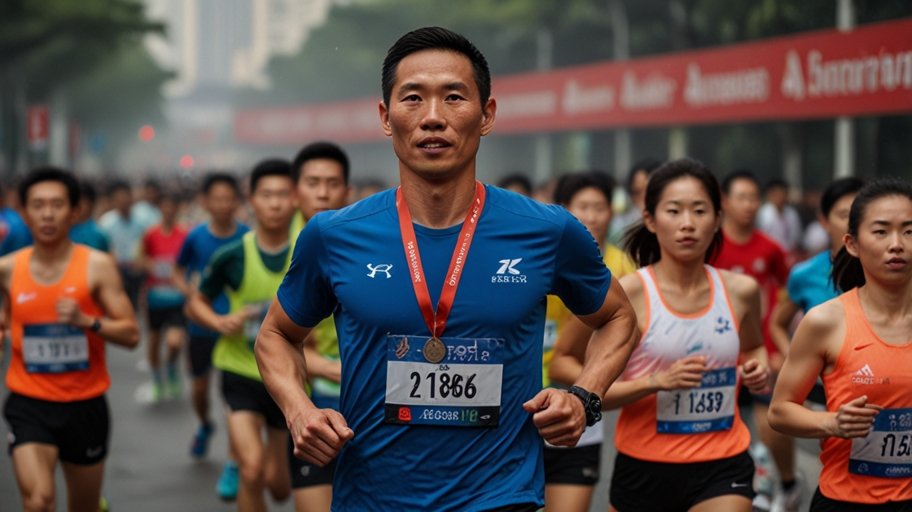The annual Guangzhou Marathon was recently celebrated with astonishingly high attendance rates alongside an array of incredible performances, making it absolutely clear that this running event has become one of the big names in Asia.
30,000 participants have been counted who have traveled from all over China and 42 different countries to wear the streets of this Southern metropolis with prestige and joy.
Not only was the weather perfect this morning for the race, but it was also an all-time very good condition for runners to complete the 42.195 m distance of the marathon because the weather was mild, and there was a long shadow of wind.
Importantly, the route ran through the most attractive parts of the city, encircling the new and old buildings and gardens, which was a perfect idea.
The men’s elite category resulted in an adrenaline-pumping finish following which the top Ethiopian runner managed to finish the race in 2:07:43 just 12 mere seconds behind the time that would allow him to break the course record.
On the other hand, the Kenyan lady did the 2:22:18 race in the women’s category thus proving her indomitability in the marathon.
The population of China was proud of their indigenous stars who ranked high in both men’s and women’s events of running. First, the top male local racer covered the route of duty in 2:11:36 being more than 5 minutes faster than the best previous runner. Similarly, the leading woman from China thrived significantly better than previously by finishing in 2:26:51.
15,000-plus participants ran the 21.1 km track which became the major distance in the event. Moreover, the wheelchair race category depicted a significant increase in participant numbers that reflects the event’s inclusivity policy and also the blind and heard-of-hearing conditions in people.
“Representative of the vibrant, forward-thinking and open to all, our marathon is the epitome of the spirit that our city embodies,” remarked the director of the event during the giving of the awards. In 2012, when the event was first introduced in the market, it was an unknown annual competition. However, after being completely successful for nine consecutive years now, it has become one of the most prestigious in China.
The security measures were comprehensive and unobtrusive, given that over 2,000 volunteers were deployed along the course, in order to facilitate the needs of runners. The medical teams were positioned strategically and luckily only a few minor cases were reported that required their attention.
The economic success of the event is one of the contributing factors to the prosperity of Guangzhou, since it led to the hotels’ full occupancy and the restaurants’ great business that happened during the marathon weekend. Local authorities estimated that the event brought about 120 million yuan to the city.
The focus on environmental issues was evident as the organizers adopted a sustainability plan that was very comprehensive. At the hydration stations, the plastic bottles were replaced by biodegradable cups, and the officials used electric vehicles for their transportation needs throughout the event.
It was the inclusion of digital innovation that was the most notable during the marathon. It was through the event’s app that not only could the spectators trace the runners in real time but also get the athletes’ performance data. The technology was a great help to the supporters and competitors who were not present at the venue but followed the action remotely.
The marathon organized a cultural program that accompanied the marathon race with performances of traditional Cantonese opera and lion dances staged at various points along the route. This cultural representation was exclusive only to this event and was also a great way to promote local heritage.
Community outreach established a new record with more than 200 local schools engaging in various activities on the race day. Thousands of children and the sport of marathon were brought together by the children’s running program, thus becoming carriers of the physical fitness promotion paradigm of younger generations.
With numerous teams participating in the corporate challenge division it can be observed that the corporate community in China is realizing more and more the importance of sport in team-building and wellness. This perspective of the event was the key point that showed the growth of running as a rewarding team-building exercise and wellness initiative in the corporate community as well as the wider professional community in China.
The charity of the marathon event was able to collect more than 3 million yuan to be used for educational projects in rural areas of Guangdong province. The participants had the option of supporting defined causes, which also attracted a large number dedicating their run to help the underprivileged.
One participant from Australia who was participating in the Guangzhou Marathon for the first time remarked, “The spirits and the energy, I believe, was so evident in the spectators who cheered us on from the beginning to the end of the race…” in a reaction that underlined the wonderful encouragement provided by the people following the race.
The racing records remain untouched, although the men’s standard of 2:07:31 was set in 2019, while the women’s record of 2:21:52 was achieved in 2018. These historical places are still attracting the best talents in the sport who are willing to make their names on such a glorious occasion.
For the coming year, the organizers said that they are introducing a 10-kilometer event and increasing the number of participants from abroad. These plans have been made with an aim to elevate the marathon’s status to a global scale.
Nowadays, China is more influential and current in the marathon events thus the success of today’s event in particular has demonstrated the growing influence of the Chinese people in the world of long-distance running. The country has become an important and well-acclaimed destination on the global calendar for international running events with influential marathon races hosted in Beijing, Shanghai, and Guangzhou.
Health officials have found that the marathon has made big progress in public awareness of fitness. Information from the entries showed that more than 40% of the participants were first-timers, which proved that the event did not fail to encourage more citizens to run a long distance.
The course of the Guangzhou Marathon no longer exists only for the sake of the sport, because it has become a reflection of urban lifestyle and a spirit of the local community. The noisy cheering crowds and the positive atmosphere that pervaded the streets at sunrise were a source of strength for a great number of athletes.
When the last beams of sunlight hit the pavement on another episode of the Guangzhou Marathon, all the people who took part in the race joined together with the organizers to celebrate an event that was not only a new norm-setter for long-distance running in China but was also a health, social, and international friendship promoter by virtue of the spirit of the sports.









